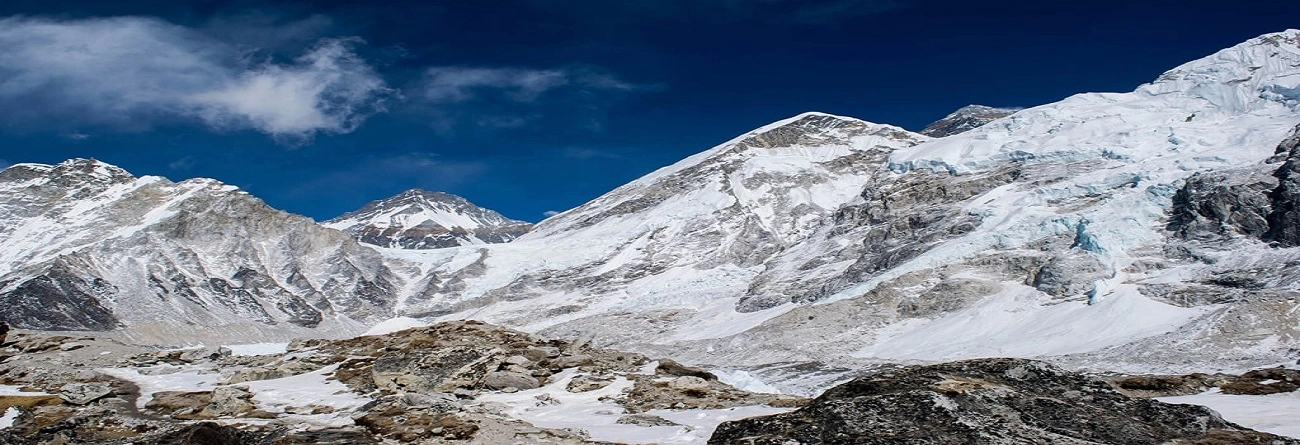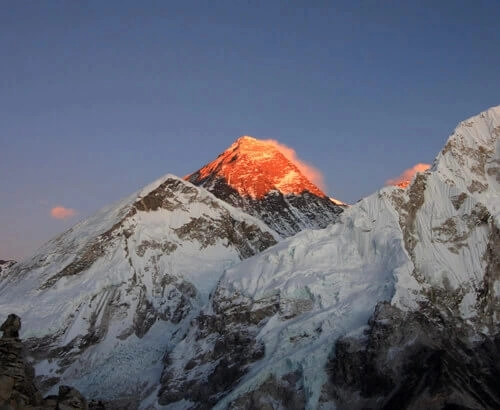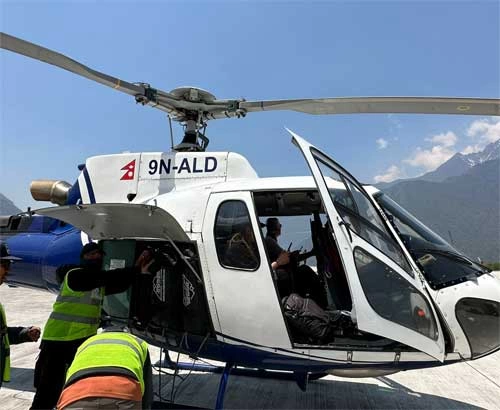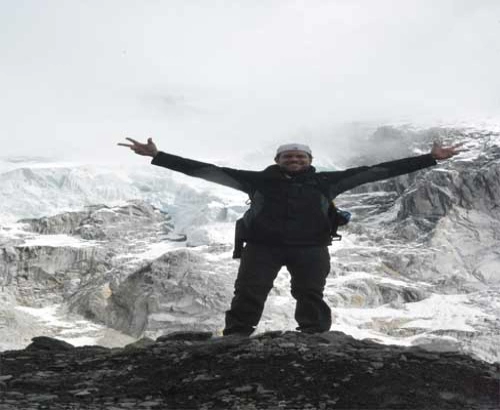 Understanding Everest Camps and the Map Route:
Understanding Everest Camps and the Map Route:
Before embarking on our exploration, let's gain a clear understanding of what the Everest camps and the map route entail. Mount Everest, located in the Himalayas, boasts several camps at different altitudes. These camps serve as pivotal acclimatization spots for climbers during their ascent to the summit.
The map route, carefully planned and strategized, guides climbers through these camps, ensuring their safety and well-being throughout the journey. Here are the four camps on Mount Everest:
Camp 1: The Gateway to Everest's Majesty
Camp 1, 6,065 m (19,900 ft), is the first stop on the Everest map route. Situated on the Khumbu Glacier, this camp offers a breathtaking view of the surrounding peaks, immersing climbers in the grandeur of the Himalayas. It is the destination after climbers leave Everest Base Camp for their expeditions.
Camp 2: The Gateway to the Lhotse Face
At an elevation of around 6,400m [20,997 feet], Camp 2 marks a significant milestone toward the Everest summit. As climbers embark on their climbing journey, leaving Camp 1 behind, they navigate through the technical cliffs and landscapes featuring blue ice and huge ice sheets. Here, climbers must navigate the treacherous Khumbu Icefall to reach this camp, making it a crucial test of their skills and determination.
Camp 3: The Camp Above the Icefall
Camp 3 is positioned at approximately 7,300 meters [23,950 feet]. It offers climbers a respite from the perilous Khumbu Icefall. With majestic views of the surrounding peaks, including the formidable Lhotse and Nuptse, this camp presents a remarkable panorama for all who dare to venture further. Remember, reaching here is not an easy feat - climbers require a high level of physical fitness, mentality, and preparation with their gear, equipment, and safety measures.
Camp 4: The Final Assault Base
Camp 4 is the scariest region of Everest. Situated at 7,906 meters [25,938 feet], Camp 4 is the summit push's launching pad. Climbers must brave the treacherous South Col and face the extreme conditions of the "Death Zone."
Major Locations: Mount Everest Diary
The Khumbu Icefall
On their way to the Everest summit, the Khumbu Icefall, also called the "Valley of Death," is their first major challenge. Icefall massive ice is a permanent labyrinth of towering seracs and deep crevasses.
Speed versus cautiousness is a delicate balance that must be traversed in this glaciated labyrinth. Climbers must take very small steps within a treacherously matted world of ice. They use ladders to cross deep crevasses and ropes to cover the steeper areas.
The Lhotse Face
Lhotse Face then lies ahead, an icy slope that challenges any climber's endurance and climbing capability. Climbing this formidable wall will involve using technical ice climbing, as well as a lot of determination. This is where fixed ropes come in handy because they act as the last lifeline for the climbers climbing this icy slope. This is the case because oxygen levels reduce markedly at this level, causing further physiological strain and emphasizing the importance of acclimatization.
The Geneva Spur
The daunting Geneva Spur is met by climbers when moving beyond Camp III. Even this rough ridge is not spared from wind storms and poses different challenges. The winding track passes through heaped stones, making each step cautious.
The Geneva Spur is a route leading to the final ridge before reaching the south col, the last camp before the climb to the summit. This section requires climbers to be precise and save their energies for the strenuous climb that awaits.
The South Col Region
This is usually an important milestone en route to the summit, as South Col is the staging area for the summit bid. The South Col is found at a height of about 7,910 meters (25,938 feet); as you can imagine, it is a cold, hostile, and barren area.
The climbers encounter brutal conditions that include freezing temperatures and hurricane gales. Without oxygen at these altitudes, this condition worsens things in the already difficult environment.
How To Prepare To Reach Everest Camps?
Physical Training: Building Strength and Endurance
Before embarking on an Everest expedition, building your physical strength and endurance is essential. Mountaineering requires immense stamina and cardiovascular fitness. Engaging in running, hiking, cycling, and weight training can help prepare your body for the rigorous climbing demands. Incorporate aerobic exercises and strength training into your fitness regimen to develop overall endurance and muscle strength.
Acclimatization: Adjusting to High Altitude
One of the critical aspects of preparing for an Everest expedition is acclimatization. As you ascend to higher altitudes, the oxygen levels decrease, and your body needs time to adapt. Gradual ascent and rest days at specific altitudes are vital for acclimatization. During these rest days, your body adjusts to the lower oxygen levels, reducing the risk of altitude sickness. Following the recommended acclimatization schedule and listening to your body's signals is crucial.
Climbing Mount Everest Total Cost
During the spring, foreigners who climb Mt. Everest will have to pay US$11,000 as a permit fee, while for autumn and winter, they will be expected to pay US$11,000 and US$5500, respectively. These permit fees are called royalties. The royalty for the Nepalese is reduced. For spring, it is Rs 75,000, for autumn, Rs 37,500, while the price goes as low as Rs 18,250 for both summer and winter seasons. The royalty fee is, however, exempted for Nepali supporters, porters, and guides. Similarly, Life insurance is mandatory for everybody seeking to climb Mount Everest.
A foreign climber may have to pay around $35,000-$70,000 for climbing mount everest. Any climber wanting to climb must receive a climbing permit from the Department of Tourism that is valid for three months.
Mount Everest Expedition Group
Solo climbers must climb Mount Everest as a team. It is commonly referred to as a climbing expedition. In the climbing permit issued by the Department of Tourism are the details of the name of the climbing mountain, the leader's name, and what kind of route should be taken.
Duration of Mt Everest Expeditions
The ascent of Mount Everest from base camp to the summit takes at least 15 days. We should also remember that the weather is not always good within this region, implying an increase in the days spent waiting for the green signal to embark on an expedition.
The first obstacle on the climb is four miles from the fourth camp up to the summit, including the balcony and Hillary Step. The climber starts climbing in the evening, around 9 pm and arrives at the highest point of the ascent approximately by eleven in the morning.
They quickly reach the lower ground following the strong winds and avalanche danger. They descend rapidly into the valley, where gales blow and avalanches frequently. Climbers usually fly back to Kathmandu by helicopter from Camp 4 or Camp three because it is dangerous and hard to descend. During their descent, climbers often go downwards with helicopters from Camp 4 or Camp 3 to Kathmandu.
Gear Essentials: What to Pack for the Expedition
Proper gear is essential for a successful Everest expedition. Here are some gear essentials you should pack:
- Mountaineering boots
- Layered clothing
- Sleeping bag
- Climbing harness
- Crampons and ice axe
- Headlamp
- Sunglasses and goggles
- Personal care items
- First aid kit
- High-altitude food and hydration
Remember to consult with experienced climbers or professionals to ensure you have the right gear for the Everest expedition.
Guides & Porters For Climbing Everest
Everest has such high inherent risks that they cannot climb it alone. Thus, experienced guides who know and experience the place are vital. These experienced individuals who know the terrain, weather conditions, and threats have priceless information about the area under study. They are vital in decision-making and show the right paths to climbers besides looking after all in the group.
It's very hard work to climb Everest that necessitates bodily strength, psychological toughness, and a comprehensive awareness of the dangers. Climbers who are determined to achieve this have to be physically prepared and have the knowledge and skills to overcome unexpected obstacles on Everest. Through this, they respect the mountain's grandness and ensure their and other people's safety on the same journey.
Safety Measures: Minimizing Risks on Everest
Safety should be a top priority during an Everest expedition. Here are some crucial safety measures to follow:
Choose a reputable expedition operator
Research and select a reliable, experienced expedition operator with a strong safety record.
Follow weather updates
Stay informed about the weather conditions and plan your climb accordingly.
Stay hydrated and well-nourished:
Proper hydration and nutrition are crucial for maintaining physical and mental well-being at high altitudes.
Rope up when necessary
Use ropes and harnesses when navigating steep and exposed sections.
Listen to your guide
Trust the expertise of your guide or Sherpa and follow their instructions.
Monitor your health
Be aware of any signs of altitude sickness or other health issues and communicate them with your team.
Note: By adhering to these safety measures, you can minimize risks and enhance the overall safety of your Everest expedition.
Preparations For The Everest Camps Ascent
Nutrition and Hydration: Fueling Your Body for Success
Proper nutrition and hydration are vital for optimal performance during an Everest camp expedition. At high altitudes, your body requires more calories to function efficiently. Focus on consuming a well-balanced diet of carbohydrates, proteins, and healthy fats.
Pack light, high-calorie snacks that are easy to digest and provide sustained energy. Stay hydrated by drinking plenty of water and electrolyte-rich fluids throughout the day.
Mental Preparation: Developing Resilience
Mental preparation is as important as physical training for climbing Everest. The mental challenges faced during the expedition can be overwhelming, and developing resilience is crucial. Practice meditation, visualization, and positive affirmations to strengthen your mental fortitude. Cultivate a positive mindset, embrace challenges, and be prepared for the unexpected. Surround yourself with a supportive network of fellow climbers, friends, and family who can provide encouragement and motivation.
Guided Expeditions vs. Independent Climbing
When preparing for an Everest expedition, you can join a guided expedition or attempt an independent climb. Both options have their pros and cons. Guided expeditions provide professional guidance, logistical support, and a structured itinerary.
On the other hand, independent climbing allows for more flexibility and self-reliance. Consider your experience level, personal preferences, and comfort with risk before deciding which approach suits you best.
Communication and Navigation: Staying Connected
Staying connected during an Everest expedition is crucial for safety and coordination. Here are some communication and navigation tools to consider:
- Satellite phone: Carry a reliable satellite phone for emergency communication without cellular coverage.
- Two-way radios: Use two-way radios to maintain communication within your climbing team.
- GPS device: Carry a GPS device to track your location and navigate challenging terrain.
- Maps and compass: Always carry detailed maps and a compass as a backup navigation system.
Regular communication with your team members and base camp is essential for coordination and safety.
Permits and Regulations: Navigating the Everest Bureaucracy
There are several series of permits climbers must adhere to ascent all four camps of Everest. First of all, to initiate the climb to Camp 1 and above, climbers must reach Everest Base Camp. And reaching the base camp requires two major permits. They are:
- Sagarmatha National Park Entry Permit
- Khumbu Municipality Entry Permit
As Everest Base Camp and Mount Everest lie within Sagarmatha National Park's protected land, climbers must obtain an entry permit. They can get the permit from Monjo Check Post or the Tourism Board in Kathmandu. The average cost of the Sagarmatha National Park Entry Permit is NRs. 3000 per person.
If you are from SAARC Nations, the cost is as minimal as NRs. 1000 per person. Similarly, for Nepalese citizens, the cost is only Nrs. 100 per person.
Khumbu Municipality Entry Permit costs around Nrs. 2000 per person, which can be obtained from the Nepal Tourism Board in Kathmandu.
Besides, the main climbing permit is not to be missed. The average cost of acquiring a climbing permit for Everest can range anywhere from USD 11,000 to USD 15,000. But the itinerary, season, and travel agency will greatly affect the total cost.
Risks and Precautions Along the Route
Altitude Sickness
Altitude sickness is one of a climber's toughest opponents on Everest. High altitude means low pressure, which automatically implies less oxygen as a result. Serious diseases, such as Acute Mountain Sickness (AMS), High Altitude Pulmonary Edema (HAPE), and High Altitude Cerebral Edema (HACE), might develop at different stations along the Everest way. These symptoms may be as mild as headaches, nausea, and serious respiratory and neurological problems.
To reduce these risks, climbers follow a slow and gradual acclimatization procedure. Long sojourns in low-altitude camps will help the body acclimatize to reduced oxygen pressure and thus prevent AMS. They use oxygen tanks, which act as supplements for their breathing at higher levels.
Unpredictable Weather Conditions
However, the Everest region is renowned for its turbulent and severe weather. It can be very challenging due to its sudden snow storms, high winds, and extreme cold that may prove fatal. Climbers have a small season window in spring and autumn with relatively better conditions than the rest of the year.
In particular, the South Col region is notorious for sudden weather changes. Temperature and visibility can change abruptly on climbers, so they must be vigilant and prepared. Decision-making should be done timeously as a storm may catch up with climbers who cannot predict such a storm.
Avalanches and Crevasse Dangers
Climbing through dangerous terrains full of avalanches and hidden crevasses makes this dangerous for the climber. The Khumbu Icefall, which is dynamic, is a source of danger. Ice towers and crevasses are gigantic, so these climbers depend on ladders to negotiate and move up and down using fixed ropes.
A big bowl-shaped valley called Western Cwm increases the risk of falling in avalanches. Traversing should be undertaken by climbers only during safe periods in order not to run into avalanches. The ability to interpret the characteristics of the terrain, as well as monitoring weather conditions, are essential in curtailing such risks.
Emergency Procedures: Dealing with Crisis Situations
Even with careful planning, emergencies can arise during an Everest expedition. Familiarize yourself with the emergency procedures and protocols. Here are some key steps to follow:
- Stay calm: Maintain composure and think rationally during a crisis.
- Assess the situation: Evaluate the severity of the emergency and prioritize actions accordingly.
- Contact the base camp: Establish communication with the base camp to alert them about the situation.
- Follow rescue protocols: Follow the protocols established by your expedition operator or local authorities.
It's essential to be prepared for emergencies and know how to respond effectively.
Physical Fitness Assessment: Are You Ready for Everest?
Before embarking on an Everest expedition, assessing your physical fitness level is crucial. Consult with a medical professional or a qualified mountaineering trainer to evaluate your readiness for the climb. A physical fitness assessment can help identify areas that require improvement and guide your training regimen.
Choosing the Right Time for Your Expedition
The timing of your Everest expedition plays a crucial role in your success and safety. Spring (April to May) and autumn (September to November) are the preferred seasons for climbing Everest. These seasons offer more stable weather conditions and lower avalanche risks. Consider consulting with experienced climbers or expedition operators to determine the best time for your expedition.
Altitude Sickness: Symptoms and Prevention
Altitude or acute mountain sickness (AMS) can be a significant concern during an Everest expedition. Here are some common symptoms of altitude sickness:
- Headache
- Nausea
- Fatigue
- Dizziness
- Loss of appetite
To prevent altitude sickness, it's important to:
- Gradually ascend to allow for acclimatization
- Stay hydrated and avoid alcohol and caffeine
- Listen to your body and rest when necessary
- Carry medications such as acetazolamide as a preventive measure
If symptoms of altitude sickness persist or worsen, it's crucial to descend to a lower altitude and seek medical attention.
Training at High Altitude: Simulating Everest Conditions
Simulating Everest conditions during your training can enhance your preparation. If possible, train at high-altitude locations to familiarize yourself with the challenges of reduced oxygen levels. This can help your body adapt and build resilience before the actual expedition.
Sleeping at Altitude: Coping with Discomfort
Sleeping at high altitudes can be challenging due to the thinner air and colder temperatures. Here are some tips for coping with discomfort and ensuring restful sleep:
- Use a high-quality sleeping bag rated for cold temperatures.
- Use insulated sleeping pads or mattresses to insulate yourself from the cold ground.
- Keep hydrated and avoid excessive fluid intake before bedtime to prevent frequent trips to the bathroom.
- Practice relaxation techniques such as deep breathing or meditation to promote better sleep.
- High-Altitude Climbing Techniques: Ropes, Crampons, and Ice Axes
Learning Techniques for Everest Climbing
Climbing at high altitudes requires specific techniques and equipment. Here are some essential techniques to familiarize yourself with:
- Rope techniques: Learn to use fixed ropes and ascend or descend safely.
- Crampon techniques: Practice walking with crampons on icy surfaces to maintain stability.
- Ice Axe techniques: Learn different techniques for self-arrest and traversing steep slopes.
- Developing proficiency in these techniques will increase your safety and efficiency during high-altitude climbing.
Everest Expedition Insurance: Protecting Yourself and Your Investment
Obtaining comprehensive expedition insurance is crucial for protecting yourself and your investment. Expedition insurance should cover medical emergencies, evacuation, trip cancellation, and personal liability. Ensure that your insurance policy specifically covers high-altitude mountaineering and any associated risks.
The Role of Sherpas: Local Expertise and Support
Sherpas, the indigenous people of the Everest region, play a vital role in supporting climbers during expeditions. They possess extensive knowledge of the mountain and its terrain. Sherpas provide logistical support, carry heavy loads, set up camps, and ensure the safety of climbers. Their expertise and assistance are invaluable in making the Everest expedition successful.
Weather Patterns on Everest: Understanding the Mountain's Fury
Understanding the weather patterns on Everest is crucial for planning your climb. The mountain is known for its unpredictable and harsh weather conditions. Monitoring weather forecasts, consulting with experienced climbers, and being prepared for sudden changes are essential. High winds, heavy snowfall, and extreme cold can pose significant challenges, and climbers must be ready to adapt their plans accordingly.
Training in Extreme Weather Conditions
Training in extreme weather conditions can better prepare you for the challenges you may encounter on Everest. Practice hiking, camping, and climbing in cold, windy, and adverse weather conditions. This will help you develop the necessary skills and mental resilience to handle challenging situations.
The Khumbu Icefall: Navigating a Treacherous Terrain
The Khumbu Icefall is one of the most dangerous sections of the Everest climb. Navigating this treacherous terrain requires caution and proper technique. Following the established route, using fixed ropes, and moving efficiently through the icefall is essential. Always listen to your guides or Sherpas, who have extensive experience traversing this challenging section.
Summit Day: The Final Push to the Top
Summit Day is the culmination of your Everest expedition. It's a physically and mentally demanding endeavor. You will start early in the morning to enjoy the best weather conditions. The final push to the summit involves climbing steep slopes, navigating narrow ridges, and enduring the extreme cold. The determination, perseverance, and teamwork displayed on summit day are crucial for achieving your goal.
Post-Expedition Recovery: Taking Care of Your Body
After successfully summiting Everest, it's important to prioritize post-expedition recovery. Your body has undergone immense physical and mental stress during the climb. Allow yourself enough time to rest, replenish your energy, and recover. Follow a gradual reintegration plan for physical activities and seek professional guidance if needed.
Frequently Asked Questions
How long does it take to prepare for an Everest expedition?
The preparation timeline varies depending on individual fitness levels and experience. It's recommended to allocate at least 12 to 18 months for comprehensive physical training and logistical preparations.
Can I climb Everest without prior mountaineering experience?
Climbing Everest without prior mountaineering experience is highly discouraged. It's crucial to have significant climbing experience, preferably high-altitude peaks, technical skills, and knowledge of the mountain environment.
How much does an Everest expedition cost?
The cost of an Everest expedition can range from $30,000 to $45,000 or more [for premium packages], depending on various factors such as the expedition operator, services provided, and logistics involved.
Are there age restrictions for climbing Everest?
The minimum age requirement set by the Nepalese government for climbing Everest is 18 years old. However, there is no specific upper age limit, and individuals must meet certain fitness and health criteria to participate.
What are the risks associated with climbing Everest?
Climbing Everest involves inherent risks such as altitude sickness, extreme weather conditions, avalanches, and physical injuries. Adequate preparation, experienced guides, and proper safety measures can somewhat mitigate these risks.
How many people have successfully climbed Everest?
As of the latest records, approximately 11,346 summit ascents by 6,098 people have been recorded since the first ascent in 1953. The number continues to grow as more climbers attempt the challenge.
What happens to the waste generated during Everest expeditions?
Waste management on Everest is a significant concern. Efforts are being made to promote responsible climbing practices and minimize the environmental impact. Waste is collected and returned to the base camp for proper disposal and recycling.
Final Say
Climbing Mount Everest involves careful planning, understanding of the route, and safety considerations. We have explored the journey that involves crossing terrains like the Khumbu Icefall and the Lhotse Face, dealing with the changing weather conditions, and acclimatizing to high altitudes.
It is imperative to comprehend the importance of each camp, from the fact that Everest Base Camp is the logistics base to the understanding that Camp 4 is the launch-off point for the last push. This means climbers should be in good physical condition, undergo necessary training, and use appropriate gear for success through mountain climbing.
Moreover, going through the rough terrains of Everest can lead to various life risk factors, such as high altitude sickness, changing weather conditions, and unannounced avalanche attacks. Therefore, climbers should use safety precautions, hire competent expedition operators, and clearly understand possible emergencies.
Climbing Mt. Everest is not just a physical Battle. In fact, it is also a psychological battle that requires grit, perseverance, and reverence for mountain splendor. There is no denying that experienced guides and porters, such as the famous Sherpas, are important in this Mt Everest climbing process.







